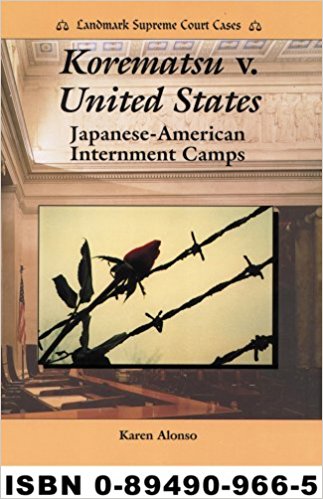Korematsu v. United States: Japanese-American Internment Camps (book)
Creators: Karen Alonso
Overview of the Korematsu Supreme Court case as part of Enslow Publishers' Landmark Supreme Court Cases series.
Synopsis
After an introduction that briefly describes Fred Korematsu 's story, Korematsu v. United States is divided into eight chapters. The first two provide an introduction to Japanese American history, from immigration and the anti-Japanese movement , to Executive Order 9066 and life in the concentration camps. Chapters three through six focus narrowly on the Korematsu case, with chapters devoted to outlining the government's arguments in the Supreme Court case, Korematsu's arguments, the Supreme Court's ruling (including the majority opinion and the three dissenting opinions), and the coram nobis case . The final chapter includes a brief overview of the redress movement and a situating of the Korematsu case with prior cases focusing on racial discrimination and with then contemporary issues, such as the immediate suspicions directed against Arabs and Muslims after the Oklahoma City bombing in 1995.
Relative to other books on Korematsu, there is little biographical material on the man and his late life civil right activism nor on the other key Japanese American civil rights cases.
The book also includes an author's note, a glossary (mostly of legal terms), and suggestions for further readings. In addition to including government photographs of the roundup and incarceration, the final two chapters include several photographs from the collection of the National Coalition for Redress/Reparations (NCRR).
Additional Information
Author Karen Alonso is an attorney who wrote a series of five children's books for Enslow from 1998 to 2002 focusing on key legal cases in history. The Korematsu book was the first to be published.
The book is generally well researched in its narrow focus on the case. Among the few errors: a claim that the 1924 "Naturalization Act" determined that Issei could not become naturalized U.S. citizens (page 15; the Ozawa Supreme Court case two years earlier had definitively determined the status of Issei citizenship); claiming that "[p]rior to the 1950s, the only way a person of Japanese ancestry could become a citizen of the United States was to be born in the United States" (15; there were a few exceptions to this general rule, the most notable being Issei World War I veterans, who were granted eligibility for citizenship in 1935 legislation); twice misspells Granada as "Grenada" (45); a claim that the " loyalty questionnaire " episode "came toward the end of the evacuation program" (43; the questionnaire was administered in early 1943, over two years before the closing of the camps); calls Wayne Collins "an attorney with the California office of the American Civil Liberties Union " (57; he was affiliated with the Northern California office of the ACLU, whose stance on the Japanese American cases differed from that of the Southern California office and of the national office).
Find in the Digital Library of Japanese American Incarceration
Korematsu v. United States: Japanese-American Internment Camps
This item has been made freely available in the Digital Library of Japanese American Incarceration , a collaborative project with Internet Archive .
Might also like
Korematsu v. United States: Japanese-American Internment
by Susan Dudley Gold;
Korematsu v. The United States: World War II Japanese-American Internment Camps
by Karen Latchana Kenney;
Fred Korematsu Speaks Up
by Laura Atkins and Stan Yogi
Related Articles
| Author | Karen Alonso |
|---|---|
| Pages | 128 |
| Publication Date | 1998 |
